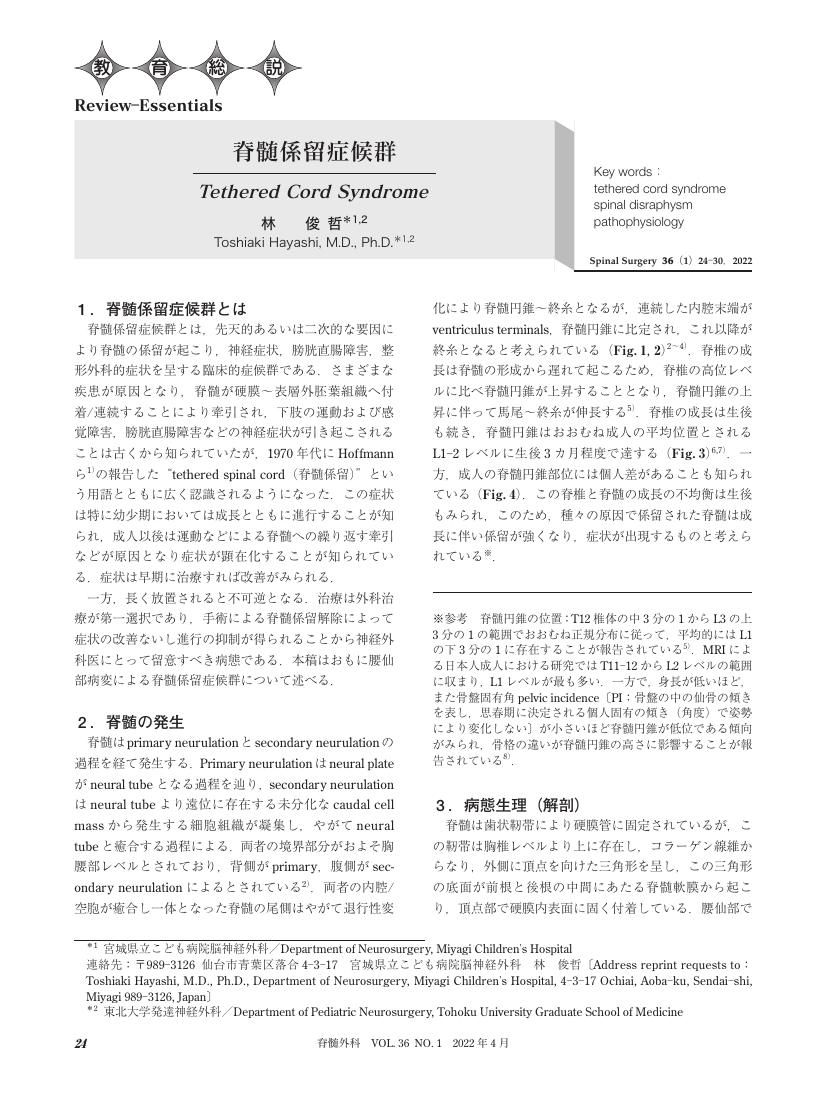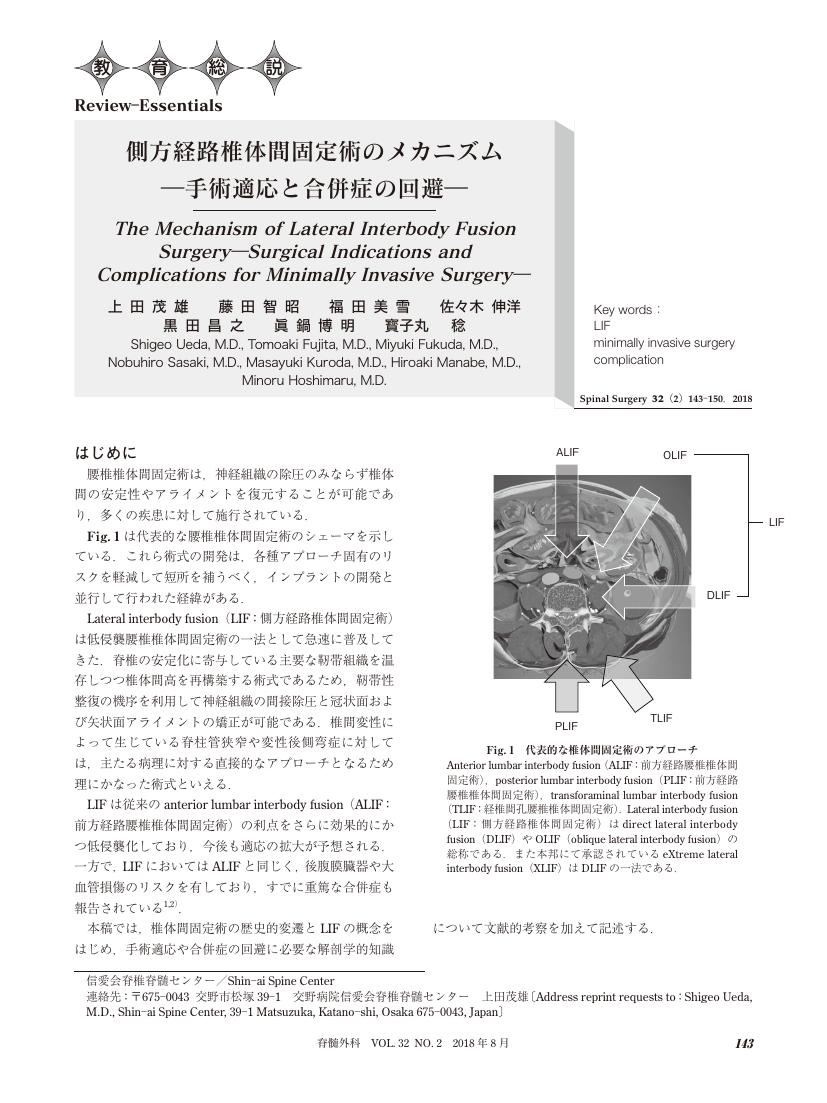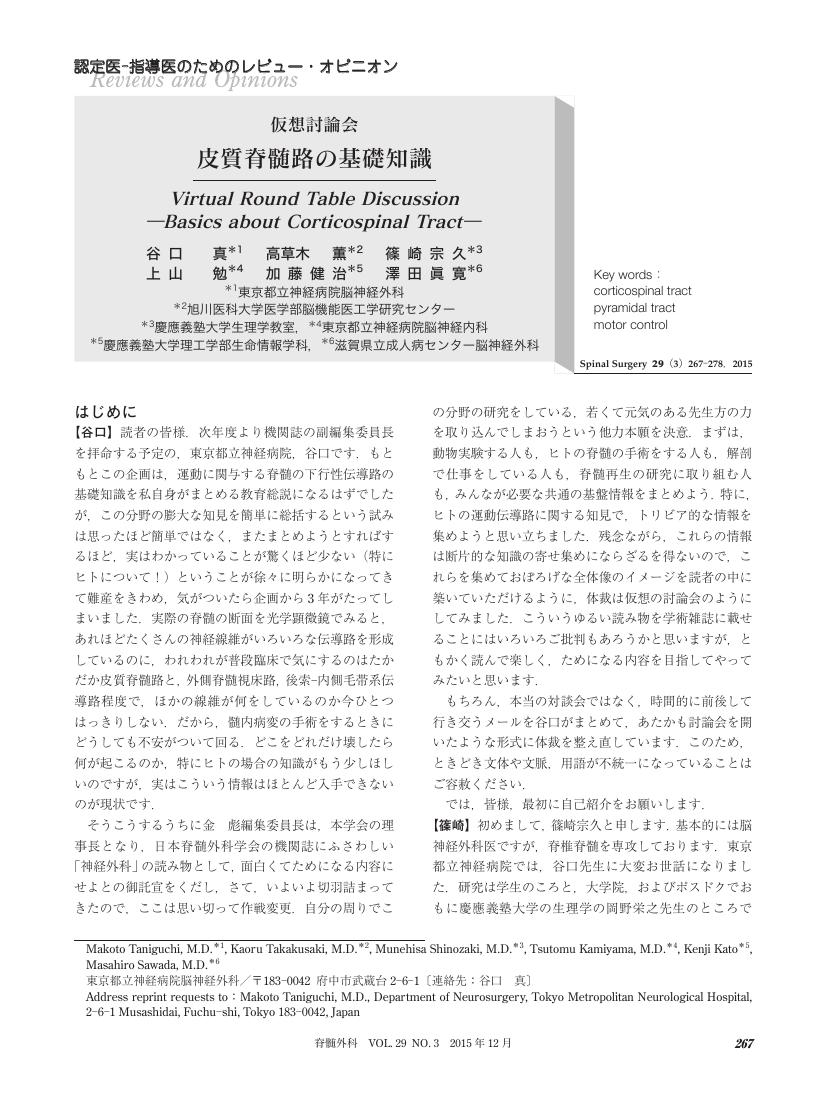81 0 0 0 OA 大脳皮質・脳幹-脊髄による姿勢と歩行の制御機構
- 著者
- 高草木 薫
- 出版者
- 日本脊髄外科学会
- 雑誌
- 脊髄外科 (ISSN:09146024)
- 巻号頁・発行日
- vol.27, no.3, pp.208-215, 2013 (Released:2017-05-11)
- 参考文献数
- 39
- 被引用文献数
- 1
This review discusses neuronal mechanisms controlling posture and locomotion. Volitional gait behaviors are composed of “automatic control of posture and rhythmic limb movements” that operate in conjunction with “intentional control of precise movements of the trunk, limbs, and feet.” The automatic control of posture and rhythmic limb movements is mediated by the ventromedial descending motor system from structures of the brainstem. Descending signals in this system activate spinal interneuronal circuits, which are termed central pattern generators (CPGs), to automatically generate a locomotor rhythm and pattern in cooperation with sensory afferents from muscles, joints, and skin. However, when moving, the subject requires intentional gait modification, which in turn critically involves an activation of the dorsolateral descending motor system, or the lateral corticospinal tract, arising from the motor cortical areas. An intentional gait control is always preceded by appropriate postural adjustments, which are themselves achieved by the motor programs in motor cortical areas including the supplementary motor area and premotor area. To generate and develop the motor programs, information of bodily function such as body schema, which is always updated at the temporoparietal cortex on the basis of proprioceptive, visual, vestibular and auditory sensations, can be critically required. The postural control program is propagated to the brainstem, via the cortico-reticular projection, so that anticipatory postural adjustment is performed by the activation of the ventromedial systems immediately before the onset of the intentional gait modification. Conversely, programs of intentional gait control are transmitted to the primary motor cortex so that precise limb trajectories can be generated and accurate foot placement is achieved by the activation of the corticospinal tract. Signals from the basal ganglia and the cerebellum regulate “automatic processes” by acting on the brainstem and “intentional processes” by acting on the cerebral cortex. Operation of the basal ganglia is largely affected by dopamine, and cerebellar function depends on feed-forward and feedback signals acting on the cerebellum. Dysfunction of either mechanism of the above processes may result in postural disturbance and/or gait failure. (328 words)
52 0 0 0 OA 気象変化と痛み
- 著者
- 佐藤 純
- 出版者
- 日本脊髄外科学会
- 雑誌
- 脊髄外科 (ISSN:09146024)
- 巻号頁・発行日
- vol.29, no.2, pp.153-156, 2015 (Released:2016-01-20)
- 参考文献数
- 18
- 被引用文献数
- 3 4
慢性痛が天気の崩れで悪化することは以前より知られており, 疼痛治療の臨床において重要な問題である. 筆者は, 気象要素 (気圧, 気温) による慢性痛悪化のメカニズム研究により, 日常体験する程度の軽微な気圧変化あるいは低温への曝露が慢性痛モデル動物の痛み行動を増強し, 慢性痛有訴者の症状を再現することを実証してきた. また, 気圧変化による痛みの増強には内耳の気圧感受メカニズムが関与することを明らかにし, 温度変化による痛みの増強には皮膚の温度受容線維の反応性の変化が原因である可能性を示した. また, 慢性痛有訴者の一部では気圧や気温の変化に対して自律神経系が過剰に反応することがあり, それが症状悪化のもう1つの原因であることを示唆した.
38 0 0 0 OA 脊柱と椎骨の形態学
- 著者
- 犬塚 則久
- 出版者
- 日本脊髄外科学会
- 雑誌
- 脊髄外科 (ISSN:09146024)
- 巻号頁・発行日
- vol.28, no.3, pp.239-245, 2014 (Released:2017-05-11)
- 参考文献数
- 8
The spinal column of a human body must support the weight of the upper half of the body including the head and the upper limbs, befitting to the bipedal upright posture. Vertebral bodies of the lower lumbar are larger than the upper one for this support. Since the ventral side of the spinal column has a thorax, cervical and lumbar lordoses are indispensable to bring the center of gravity close to a centroidal line. Therefore, the thickness of the inferior lumbar vertebrae are greater ventrally, and an intervertebral disk is thick, and wedge-shaped. Since the weight shifts forward and backward as to the standing and the sitting position, the angle of a pelvis must be changed, and a sacrum and lumbar vertebrae cannot be unified. The lumbar vertebrae at the time of a walk should take the rotational shear, between an upper-limb-thorax block and a lower-limb-pelvis block, since they can hardly rotate due to the dissociation of the center of the rotary axis and the actual center of the vertebral bodies. The situation results in propensity for disk herniation or compressive fractures.
16 0 0 0 OA 低髄液圧症候群診断の混乱について
- 著者
- 土居 浩 中村 精紀 望月 由武人 徳永 仁 吉田 陽一 大橋 元一郎 井田 正博
- 出版者
- 日本脊髄外科学会
- 雑誌
- 脊髄外科 (ISSN:09146024)
- 巻号頁・発行日
- vol.23, no.2, pp.211-217, 2009 (Released:2017-05-11)
- 参考文献数
- 14
Spontaneous spinal cerebrospinal fluid (CSF) leaks are an increasingly recognized cause of intracranial hypotension. Comprehensive diagnostic criteria encompassing the varied clinical and radiographic manifestations of spontaneous intracranial hypotension are not available. In this report the authors review the diagnosis of the point of cerebrospinal fluid leak. The major presenting symptoms include postural headaches, nausea, vomiting, and diplopia. Often, there is no history of traumatic injury. The most common cranial magnetic resonance (MR) imaging features include pachymeningeal gadolinium enhancement. MR myelography is a non invasive method to detect CSF leakage, however, extradural hyperintensity on MR myelography is non-specific for CSF. Fat-saturated T2-weighted imaging and post contrast T1-weighted imaging should be added to confirm CSF leakage. On spinal MR images, meningeal cysts and extradural venous plexus are frequently misdiagnosed as CSF leakage. In cases in which symptoms are severe and refractory to less invasive measures, surgical intervention is indicated. Recently, some authors reported the identification of upper cervical epidural fluid collections as a false localizing sign in patients with spontaneous intracranial hypotension (SIH) and this has provided significant insight into the selection of management options. However, herein we report on true C1-2 CSF leakage. We examined a group of consecutive patients with 25 SIH and 13 posttraumatic CSF hypovolemia and investigated clinical, MRI, CT myelography, and radioisotope findings and therapeutic outcomes of this syndrome.
15 0 0 0 OA サルコペニアとフレイル
- 著者
- 山田 実
- 出版者
- 日本脊髄外科学会
- 雑誌
- 脊髄外科 (ISSN:09146024)
- 巻号頁・発行日
- vol.34, no.1, pp.12-19, 2020 (Released:2020-08-26)
- 参考文献数
- 22
15 0 0 0 OA 腰椎疾患に対するリハビリテーション
10 0 0 0 OA 脊髄係留症候群
10 0 0 0 OA 線維筋痛症の診断と治療
- 著者
- 村上 正人
- 出版者
- 日本脊髄外科学会
- 雑誌
- 脊髄外科 (ISSN:09146024)
- 巻号頁・発行日
- vol.30, no.3, pp.260-265, 2016 (Released:2017-01-31)
- 参考文献数
- 24
9 0 0 0 OA 鑑別疾患として知っておきたいCIDP
8 0 0 0 OA 側方経路椎体間固定術のメカニズム―手術適応と合併症の回避―
8 0 0 0 OA 仙腸関節障害の治療経験
- 著者
- 森本 大二郎 井須 豊彦 金 景成 菅原 淳 濱内 祝嗣 下田 祐介 笹森 徹 松本 亮司 磯部 正則
- 出版者
- 日本脊髄外科学会
- 雑誌
- 脊髄外科 (ISSN:09146024)
- 巻号頁・発行日
- vol.24, no.1, pp.6-11, 2010 (Released:2017-05-11)
- 参考文献数
- 22
- 被引用文献数
- 7 3
Objective : Sacroiliac joint (SIJ) dysfunction can produce lower back pain and referred symptoms in the buttocks, legs and groin. Approximately 3.5~30% of all lower back pain is associated with SIJ dysfunction. Recently, we have been treating more SIJ dysfunction cases due to the increasing incidence of lumbar degenerative disorder (LDD). Here we report our experience in treating 20 SIJ dysfunction patients. Patients and methods : The study involved 20 SIJ dysfunction patients (5 male and 15 female) with a mean age of 67.6 years (range 35~81 years). SIJ dysfunction was diagnosed using the one finger test, modified Newton test and sacroiliac joint block. Patients initially underwent conservative treatment, including sacroiliac joint block, stabilization using pelvic belts and rehabilitation. Sixteen patients underwent surgery for LDD. The mean follow-up period was 4.1 months. The clinical outcomes were evaluated using the Japan Orthopedic Association Scale score (JOA score). Results : All patients with SIJ dysfunction showed symptom improvement. In the group of the patients who underwent the LDD operation, the improvement score and recovery rate of treatments for SIJ dysfunction tended to be lower than for those without surgery for LDD. Fourteen patients (70%) had some referred symptoms in the leg and lower abdomen. Conclusion : Our treatment of SIJ dysfunction resulted in good clinical outcomes. SIJ dysfunction should be considered a cause of lower back pain and a potential factor in failed back surgery. SIJ dysfunction should be considered when designing treatments for LDD.
7 0 0 0 OA 姿勢の評価と治療アプローチ
7 0 0 0 OA デルマトーム図
7 0 0 0 OA 上殿皮神経障害のレビュー
6 0 0 0 OA 仮想討論会 皮質脊髄路の基礎知識
6 0 0 0 OA 腰痛に対する運動療法 —理学療法的視点から—
- 著者
- 相羽 宏 舟崎 裕記 川井 謙太朗
- 出版者
- 日本脊髄外科学会
- 雑誌
- 脊髄外科 (ISSN:09146024)
- 巻号頁・発行日
- vol.31, no.2, pp.140-144, 2017 (Released:2017-10-28)
- 参考文献数
- 16
Exercise therapy is useful for low back pain. Exercise therapy aims to improve postural alignment, muscle strength, and endurance, and also contributes to pain relief and the prevention of recurrences.Furthermore, exercise therapy helps to reduce the psychological burden in chronic low back pain patients. Exercise therapy for low back pain is divided into two major categories : stretching for flexibility and motor control for lumbar spine and pelvic stability. Patients with low back pain reportedly have less trunk and lower limb flexibility. Flexibility can be enhanced with trunk and lower limb stretching, which contributes to the maintenance of postural alignment under gravity. Trunk stability exercises using the inner unit have been widely applied for nervous, skeletal,and muscular system coordination as well as lumbar spine dynamic stability
5 0 0 0 OA 痛みの伝導路—歴史から学ぶ—
4 0 0 0 OA 脊髄拡散テンソルイメージングの最前線
- 著者
- 坂本 真一 三木 幸雄
- 出版者
- 日本脊髄外科学会
- 雑誌
- 脊髄外科 (ISSN:09146024)
- 巻号頁・発行日
- vol.29, no.3, pp.279-286, 2015 (Released:2016-04-01)
- 参考文献数
- 56
水分子の拡散現象を画像化した拡散画像の中でも, 拡散の方向や速さの描出に特化した拡散テンソル画像は, 一方向性が強いという特徴的な構造を有する脊髄の質的評価に対して, きわめて親和性の高い画像診断法である. 拡散テンソル画像の解析から得られる各種のパラメータは, 従来の画像からは得ることのできない脊髄の微細な変化を鋭敏に反映すると考えられており, 3次元表示した拡散テンソルトラクトグラフィは, その視覚的効果から術前術中の治療計画作成にも利用されている. 現在, 拡散テンソル画像の臨床応用は急速に広がっているが, 今後はより詳細な脊髄状態の評価を可能にする非ガウス分布拡散画像に移行していくことが予想される.












